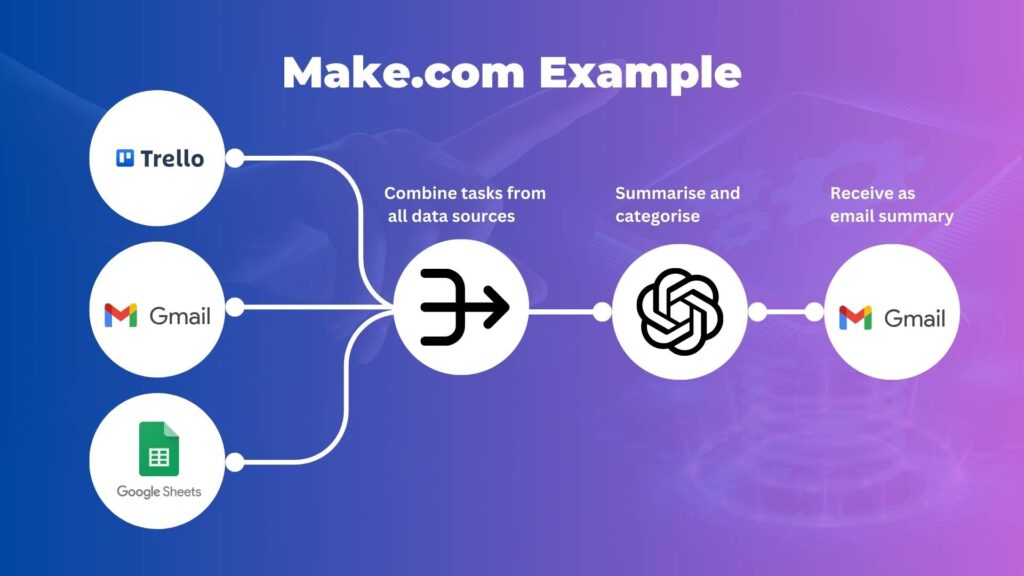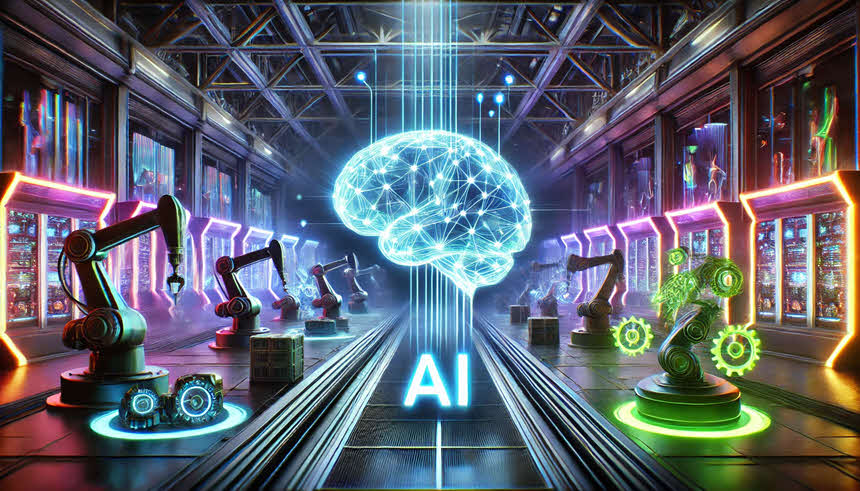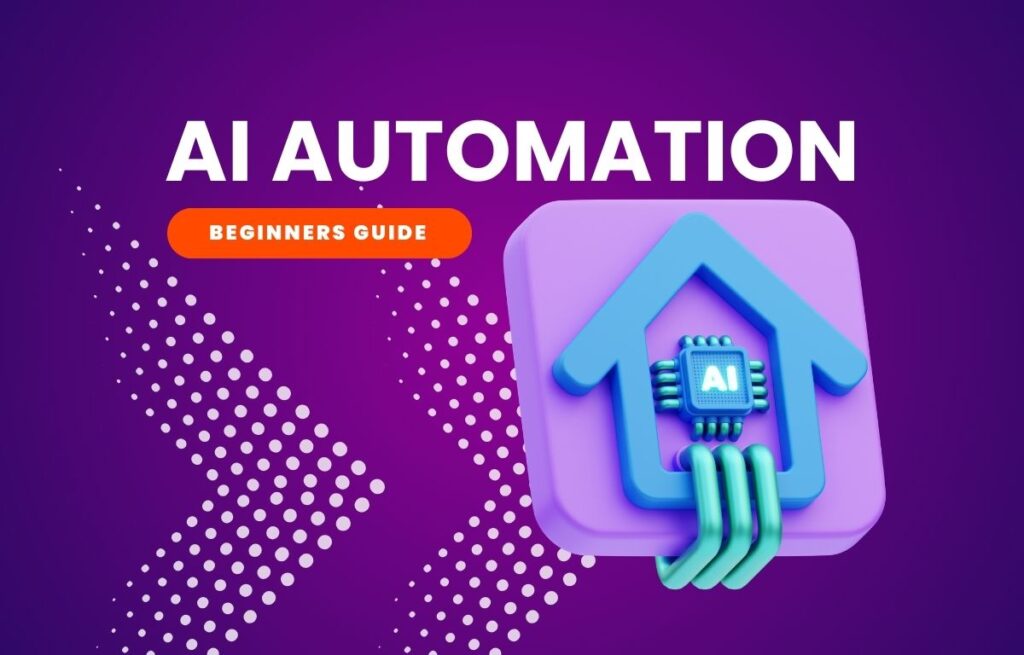As an online business owner, you’re probably feeling the pressure of keeping up with countless challenges and tasks — generating leads, creating content, handling customer inquiries, managing social media, and staying ahead of the competition. AI automation can transform how you tackle these issues, turning them from challenges into opportunities for growth. Imagine being able to flip a switch and let your processes run on auto-pilot. Let's find out how below.
The goal with automating your business processes is to eliminate the hours spent on repetitive tasks like copying data, responding to customer inquiries, managing general admin tasks, handling reporting, and other tedious processes. Another key benefit is reducing human error in your work.
With AI business automation, you can focus your energy on growing your business, fostering relationships, and innovating. For example: automated lead generation is possible by automatically qualifying leads based on their behavior, generating personalized social media content to boost engagement, and even automating email responses to frequently asked questions. It also allows you to take full control of your marketing strategy by creating consistent, high-quality content at scale without lost time.
AI can handle the mundane, freeing our brains to work on creative and strategic tasks. Imagine spending less time answering customer questions and more time designing the next big marketing campaign or brainstorming new product ideas that set you apart from your competition.
Understanding AI Automation
At its core, AI automation merges two powerful technologies:
- Artificial Intelligence: Refers to systems designed to mimic human intelligence, including decision-making, learning from experience, and adapting over time. For example, AI can learn customer behavior patterns to make better product recommendations or optimize ad targeting for your business.
- Automation: Leverages technology to execute processes or tasks without human intervention. For entrepreneurs, this means automating repetitive and time-consuming activities like data entry, lead generation, scheduling posts, or processing customer/client data. This frees you up to focus on more strategic areas of your business, such as innovation and customer relationships.
Together, these technologies create systems capable of analyzing data, making decisions, and taking actions with little to no input from humans. For instance, an AI-powered chatbot doesn’t just respond to queries—it learns from each interaction, improving its responses over time.
Businesses can handle complex operations more efficiently, leaving humans free to focus on strategic or creative tasks.
How Does AI Automation Work?

Picture running an online business where you need to manage tasks, generate leads, create content, and respond to customer inquiries—all at the same time. Now, imagine an intelligent system that not only handles routine customer questions but also combines your tasks, qualifies leads, schedules social media posts, and manages email follow-ups automatically. This is AI automation in action for an online business owner. It typically involves several steps:
- Content Creation and Repurposing: Platforms like Make.com or Zapier allow you to automate the entire content marketing process. Imagine writing a blog post and then having an automation workflow that turns that post into multiple social media updates, a newsletter, and even a script for a YouTube video—all without manual effort.
- Content Scheduling and Personalization: Automated workflows can schedule posts across various channels like Instagram, LinkedIn, and Twitter at optimal times. These tools can also personalize content based on user behavior—tailoring newsletters or social media posts to different segments of your audience for maximum engagement.
- Analysis and Decision-Making: Automation tools analyze content performance data, identifying what resonates best with your audience and predicting future content strategies.
- Distribution and Engagement: Platforms like Zapier facilitate content distribution—posting to different platforms, sending personalized emails, and even replying to initial inquiries via chatbots. This ensures consistent communication across all marketing channels.
- Monitoring and Feedback Loop: AI automation doesn’t just distribute content; it also monitors performance metrics in real-time, gathering insights on audience engagement. This feedback is used to refine future content strategies, ensuring continual improvement and better targeting.
By combining predictive capabilities with streamlined processes, AI automation enables systems to work smarter, not harder.
Why Businesses Are Embracing AI Automation
The growing popularity of AI automation isn’t just a trend—it’s a necessity. Businesses are under constant pressure to improve efficiency while reducing costs, and this technology checks both boxes.
Consider the e-commerce industry. Retailers are increasingly turning to email marketing automation to boost sales and engage with their customers. It's entirely possible to create an AI system that segments your audience based on behavior, automatically sends personalized offers, and follows up with cart abandonment reminders—all without you lifting a finger. This is AI at work, handling the mundane tasks and freeing our brains to focus on more creative and strategic aspects of the business, like designing new products or developing innovative marketing campaigns.
AI automation also helps with social media marketing by generating content calendars, repurposing blog posts into social media snippets, and scheduling posts for optimal engagement. In healthcare, AI automation is improving patient outcomes by scheduling appointments and flagging high-risk cases for priority care.
Key Benefits of AI Automation:

- Time and Cost Savings: Automating routine tasks such as lead qualification, customer support, and content distribution frees up valuable human resources, allowing your team to focus on high-impact activities that drive growth. For example, AI can automate responses to common customer inquiries, saving hours each day.
- Scalability: Whether you're serving 10 customers or 10,000, AI scales effortlessly. AI automation can handle increased demand without the need for extra staff, which is particularly useful during peak periods like holiday sales or product launches.
- Enhanced Decision-Making: Data-driven insights improve accuracy in planning and execution. AI can analyze customer behavior, predict trends, and provide recommendations for targeted marketing campaigns, ultimately helping you make informed business decisions.
- Improved Lead Generation and Nurturing: AI automation tools like chatbots and email automation can instantly engage website visitors, collect their information, and qualify leads based on their behavior. Automated email sequences then nurture these leads, ensuring that potential customers are followed up on without manual effort.
- Content Repurposing and Marketing Efficiency: AI can turn a single blog post into multiple forms of content, including social media updates, newsletters, and video scripts. This increases your marketing efficiency while maintaining a consistent brand message across channels. Tools like Make.com can orchestrate this entire process, freeing up creative time for strategizing your next campaign.
- Improved Customer Retention: AI can proactively identify customers who may be disengaging and initiate re-engagement campaigns to keep them interested. By sending timely discounts or personalized content, AI helps maintain strong customer relationships and improve retention rates.
- Optimized Sales Processes: AI-powered tools can help automate your sales process by tracking customer journeys, analyzing purchasing patterns, and recommending the best next actions. This helps sales teams close deals more efficiently, without having to manually keep track of every lead's status.
Applications of AI Automation
AI automation isn’t just a fancy trend—it’s the secret sauce for small businesses looking to do more with less. Imagine having a virtual assistant that handles the boring stuff while you work on your next big idea. The benefits of AI for small businesses go beyond saving time—it’s about scaling smarter, reducing stress, and keeping up with the big players without breaking a sweat.
- Marketing: Tools like HubSpot analyze customer behavior to create personalized campaigns, automatically distribute content across channels, and track performance metrics.
- E-commerce: AI automation helps streamline email marketing campaigns, providing personalized offers and managing customer inquiries. It also optimizes inventory management, ensuring products are always stocked based on predictive demand.
- Customer Service: AI bots handle FAQs, manage live chats, and escalate complex issues to human agents when necessary, offering 24/7 service and keeping response times short.
- Social Media Management: Platforms like Buffer use AI to optimize post scheduling, analyze engagement metrics, and even suggest content ideas. Automated social media interactions allow businesses to engage with their audiences without constantly monitoring every channel.
- Sales and CRM: AI-powered CRM systems automatically log communications, track customer engagement, and even predict which leads are most likely to convert, allowing sales teams to focus on the most promising opportunities.
The Path to Implementation
Getting started with AI automation doesn't require specialized technical skills—many tools are designed to be user-friendly and accessible. Many of the most popular automation tools, like Zapier and Make.com, offer free plans and intuitive drag-and-drop interfaces, making it simple to get started. The first step is to identify repetitive, time-consuming tasks in your workflow. Are you or your team spending hours on email responses, manually copying data between systems, or posting on social media? These are perfect candidates for automation.
If you're unsure where to start, think about automating lead generation or digitizing a manual process, like collecting customer information. For example, you could use Zapier to automatically capture leads from a form on your website and add them to your CRM, or set up an automated email sequence to follow up with new leads. Start small, track the results, and expand your automation once you’re confident in the technology. The key is to take manageable steps that free up your time and help you focus on growing your business.

Discover the Best AI Automation Tools
These top AI tools for small businesses make it easier than ever to tackle workflow automation with AI, freeing up your time to focus on the parts of your business that actually need your brainpower.

Relevance.ai: Unlock the potential of AI-powered insights with Relevance.ai, a platform designed to transform your data into actionable workflows. Ideal for businesses that rely on customer segmentation and personalization, it leverages machine learning to automate analytics and enhance decision-making.

Zapier: Seamlessly connect over 3,000 apps to streamline repetitive tasks without writing a single line of code. Perfect for small businesses looking to automate processes like lead tracking or email workflows effortlessly.

Make.com: Formerly Integromat, Make.com offers a visually intuitive interface for building complex, multi-step automations. It's ideal for small teams managing sophisticated workflows with ease.

Integrately: Take your automation to the next level with Integrately, where AI simplifies workflow creation and enhances productivity by suggesting pre-built integrations for your business needs.

Pabbly Connect: Affordable and powerful, Pabbly Connect lets you automate processes across multiple apps without monthly limits. Great for budget-conscious entrepreneurs diving into AI automation.

Relay.app: This innovative platform brings a "human in the loop" approach to AI automation, allowing users to handle exceptions manually while automating routine tasks—perfect for marketing automation, customer service or QA processes.
Challenges to Consider
While AI automation offers great benefits, it also comes with some challenges. Many automation platforms have free plans that make it affordable to get started. Tools like OpenAI, Google Gemini, or Claud can be used from as little as $20 per month, and their API can integrate with other platforms for just a few extra dollars. For example, with a small additional investment, you can connect ChatGPT to your automation tools like Zapier or Make.com to handle customer inquiries, lead generation, and content creation seamlessly.
Acronyms and Terminology for AI Automation
- API (Application Programming Interface): APIs enable AI tools to communicate and share data with other systems, creating seamless integrations for automation. Think of it as the bridge connecting your automation tools like Zapier to your CRM or social media platforms.
- RPA (Robotic Process Automation): This technology automates repetitive, rule-based tasks like data entry or invoice processing. RPA often works hand-in-hand with AI to handle more complex workflows.
- Chatbots: AI-driven programs that simulate human conversations, often used for customer support or lead generation. These bots can analyze text, learn from interactions, and automate responses, making them integral to AI-powered communication.
- Predictive Analytics: The use of AI to analyze data and predict future outcomes, such as customer behavior or sales trends. This forms the foundation for smarter automation strategies in business processes.
- Orchestration: A more advanced form of automation where AI coordinates multiple workflows across systems, ensuring that tasks happen in the correct sequence without human intervention.
- Data Annotation: The process of labeling datasets to train AI models. For instance, tagging email categories (support, sales, spam) so an AI tool can automate sorting effectively.
- Intelligent Automation: A combination of AI and RPA, where decision-making capabilities of AI enhance rule-based automation. This creates more adaptable systems for tasks like dynamic pricing or customer segmentation.
- Digital Twins: Virtual replicas of physical systems or processes used to simulate and optimize operations before implementing changes in the real world, often used in industrial AI automation.
- Hyperautomation: The practice of automating as many processes as possible using a combination of AI, machine learning, and RPA. It represents the ultimate goal of seamless, end-to-end automation.
- Event-Driven Automation: A system that triggers workflows based on specific actions or conditions, such as sending a personalized email when a customer signs up or a chatbot starting a conversation when a website visitor lingers on a page.
Conclusion
AI automation is more than just a trend—it's a real opportunity to transform your business operations. By automating repetitive tasks and using AI to support better decision-making, you can unlock new levels of efficiency, growth, and creativity. The key is to start small: identify a few tasks to automate, test the process, and scale as you see results.
Take the leap into AI automation by starting with something simple—automate a daily task and see the impact on your time and productivity. The future of your business can be more streamlined and effective—one small step at a time.


With 20+ years in eCommerce and a proven history of scaling a 7-figure business, I know how to transform challenges into opportunities for growth. As the former Head of E-commerce for a European food tech company, I managed 14 e-shops across Europe and South Africa. Now, I specialise in helping professionals like you unlock the potential of AI automation for your business.
Over 1,800 students have already enrolled in my online courses to master these skills. Whether you’re looking for hands-on AI automation services or want to upskill with my courses, I’m here to help. Connect with me on LinkedIn to discuss your needs or join my programs to start building smarter, more scalable systems today!

